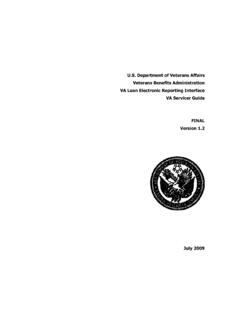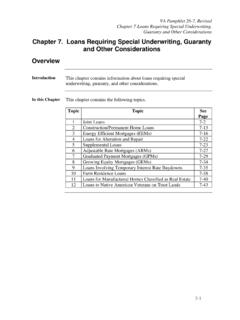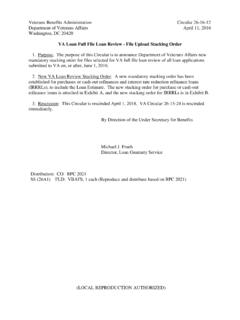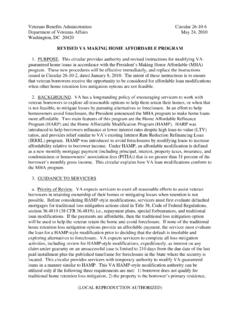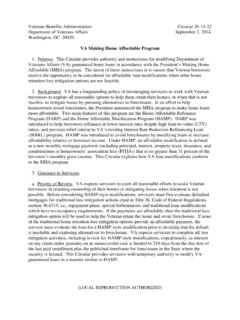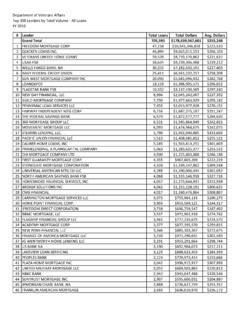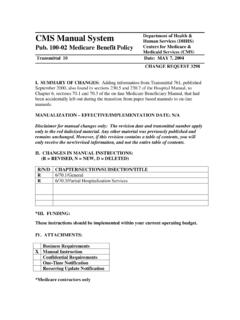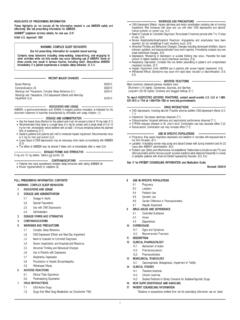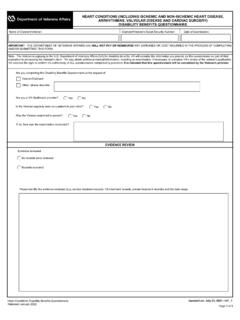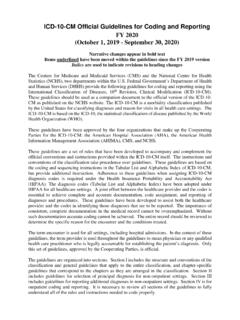Transcription of NECK (CERVICAL SPINE) CONDITIONS DISABILITY BENEFITS ...
1 Updated on June 17, 2020 ~v20_2 Page 1 of 13 Neck (Cervical Spine) CONDITIONS DISABILITY BENEFITS Questionnaire Released January 2022 NECK (CERVICAL SPINE) CONDITIONS DISABILITY BENEFITS QUESTIONNAIREC laimant/Veteran's Social Security NumberName of Claimant/VeteranSECTION I - DIAGNOSISNote: These are condition(s) for which an evaluation has been requested on an exam request form (Internal VA) or for which the Veteran has requested medical evidence be provided for submission to List the claimed condition(s) that pertain to this questionnaire:Note: These are the diagnoses determined during this current evaluation of the claimed condition(s) listed above. If there is no diagnosis, if the diagnosis is different from a previous diagnosis for this condition, or if there is a diagnosis of a complication due to the claimed condition, explain your findings and reasons in the remarks section.
2 Date of diagnosis can be the date of the evaluation if the clinician is making the initial diagnosis or an approximate date determined through record review or reported of ExaminationAmbidextrousLeftRightDominant hand:DOMINANT HANDNote - The Veteran is applying to the Department of Veterans Affairs (VA) for DISABILITY BENEFITS . VA will consider the information you provide on this questionnaire as part of their evaluation in processing the Veteran's claim. VA may obtain additional medical information, including an examination, if necessary, to complete VA's review of the veteran's application. VA reserves the right to confirm the authenticity of ALL questionnaires completed by providers. It is intended that this questionnaire will be completed by the Veteran's - THE DEPARTMENT OF VETERANS AFFAIRS (VA) WILL NOT PAY OR REIMBURSE ANY EXPENSES OR COST INCURRED IN THE PROCESS OF COMPLETING AND/OR SUBMITTING THIS FORM.
3 Are you completing this DISABILITY BENEFITS Questionnaire at the request of:Veteran/ClaimantOther: please describeAre you a VA Healthcare provider?Is the Veteran regularly seen as a patient in your clinic? YesNoYesNoWas the Veteran examined in person? YesNoIf no, how was the examination conducted?Please identify the evidence reviewed ( service treatment records, VA treatment records, private treatment records) and the date range. Evidence reviewed:EVIDENCE REVIEWNo records were reviewedRecords reviewedUpdated on June 17, 2020 ~v20_2 Page 2 of 13 Neck (Cervical Spine) CONDITIONS DISABILITY BENEFITS Questionnaire Released January 20222B. Does the Veteran report flare-ups of the cervical spine?2C. Does the Veteran report having any functional loss or functional impairment of the joint or extremity being evaluated on this questionnaire, including but not limited to after repeated use over time?
4 If yes, document the Veteran's description of the flare-ups he/she experiences, including the frequency, duration, characteristics, precipitating and alleviating factors, severity, and/or extent of functional impairment he/she experiences during a flare-up of symptoms:If yes, document the Veteran's description of functional loss or functional impairment in his/her own II - MEDICAL HISTORY2A. Describe the history (including onset and course) of the Veteran's cervical spine condition (brief summary):1B. Select diagnoses associated with the claimed condition(s) (check all that apply):Ankylosing spondylitisCervical strainIntervertebral disc syndrome (Note: See VA definition of IVDS in Section X.)Spinal fusionSpinal stenosisSpondylolisthesisDate of diagnosis:ICD Code:ICD Code:Date of diagnosis:ICD Code:Date of diagnosis:Date of diagnosis:ICD Code:Date of diagnosis:ICD Code:ICD Code:Degenerative arthritisVertebral dislocationVertebral fractureICD Code:Date of diagnosis:ICD Code:Date of diagnosis:Date of diagnosis:Date of diagnosis:ICD Code:Traumatic paralysis, completeDate of diagnosis:ICD Code:Degenerative disc disease other than intervertebral disc syndrome (IVDS)ICD Code:Date of diagnosis:1C.
5 If there are additional diagnoses pertaining to cervical spine CONDITIONS , list using above format:SECTION I - DIAGNOSIS (continued)Segmental instabilityICD Code:Date of diagnosis:The Veteran does not have a current diagnosis associated with any claimed CONDITIONS listed above. (Explain your findings and reasons in the remarks section)Other (specify)ICD Code:Date of diagnosis:Other diagnosis #1:ICD Code:Date of diagnosis:Other diagnosis #2:ICD Code:Date of diagnosis:Other diagnosis #3:Updated on June 17, 2020 ~v20_2 Page 3 of 13 Neck (Cervical Spine) CONDITIONS DISABILITY BENEFITS Questionnaire Released January 20223A. Initial ROM measurementsUnable to testNot indicatedIf "Unable to test" or "Not indicated", please explain:All normalAbnormal or outside of normal rangeIf ROM is outside of "normal" range, but is normal for the Veteran (for reasons other than a neck condition, such as age, body habitus, neurologic disease), please describe:If yes, please explain:NoYesIf abnormal, does the range of motion itself contribute to a functional loss?
6 Right lateral rotation endpoint (80 degrees):Forward flexion endpoint (45 degrees):Extension endpoint (45 degrees):Right lateral flexion endpoint (45 degrees):Left lateral flexion endpoint (45 degrees):Left lateral rotation endpoint (80 degrees):degreesdegreesdegreesdegreesdeg reesdegreesActive Range of Motion (ROM) - Perform active range of motion and provide the ROM III - RANGE OF MOTION (ROM) AND FUNCTIONAL LIMITATIONST here are several separate parameters requested for describing function of a joint. The question "Does this ROM contribute to a functional loss?" asks if there is a functional loss that can be ascribed to any documented loss of range of motion; and, unlike later questions, does not take into account the numerous other factors to be considered.
7 Subsequent questions take into account additional factors such as pain, fatigue, weakness, lack of endurance, or incoordination. If there is pain noted on examination, it is important to understand whether or not that pain itself contributes to functional loss. Ideally, a claimant would be seen immediately after repetitive use over time or during a flare-up; however, this is not always feasible. Information regarding joint function on repetitive use is broken up into two subsets. The first subset is based on observed repetitive use, and the second is based on functional loss associated with repeated use over time. The observed repetitive use section initially asks for objective findings after three or more repetitions of range of motion testing.
8 The second subset provides a more global picture of functional loss associated with repetitive use over time. The latter takes into account medical probability of additional functional loss as a global view. This takes into account not only the objective findings noted on the examination, but also the subjective history provided by the claimant, as well as review of the available medical evidence. Optimally, a description of any additional loss of function should be provided - such as what the degrees of range of motion would be opined to look like after repetitive use over time. However, when this is not feasible, an "as clear as possible" description of that loss should be provided. This same information (minus the three repetitions) is asked to be provided with regards to : For any joint condition, examiners should address pain on both passive and active motion, and on both weight-bearing and nonweight-bearing.
9 If testing cannot be performed or is medically contraindicated (such as it may cause the Veteran severe pain or the risk of further injury), an explanation must be given below. Please note any characteristics of pain observed on examination (such as facial expression or wincing on pressure or manipulation).NoYesCan testing be performed?If no, provide an explanation:Updated on June 17, 2020 ~v20_2 Page 4 of 13 Neck (Cervical Spine) CONDITIONS DISABILITY BENEFITS Questionnaire Released January 2022If noted on examination, which ROM exhibited pain (select all that apply):Forward flexionExtensionLeft lateral flexionRight lateral flexionRight lateral rotationLeft lateral rotationIf any limitation of motion is specifically attributable to pain, weakness, fatigability, incoordination, or other.
10 Please note the degree(s) in which limitation of motion is specifically attributable to the factors identified and flexionExtensionLeft lateral flexionRight lateral flexionRight lateral rotationLeft lateral rotationDegree endpoint (if different than above)Degree endpoint (if different than above)Degree endpoint (if different than above)Degree endpoint (if different than above)Degree endpoint (if different than above)Degree endpoint (if different than above)SECTION III - RANGE OF MOTION (ROM) AND FUNCTIONAL LIMITATIONS (continued)Right lateral rotation endpoint (80 degrees):Forward flexion endpoint (45 degrees):Extension endpoint (45 degrees):Right lateral flexion endpoint (45 degrees):Left lateral flexion endpoint (45 degrees):Left lateral rotation endpoint (80 degrees):degreesdegreesdegreesdegreesdeg reesdegreesSame as active ROMSame as active ROMSame as active ROMSame as active ROMSame as active ROMSame as active ROMP assive Range of Motion - Perform passive range of motion and provide the ROM passive range of motion testing performed?



